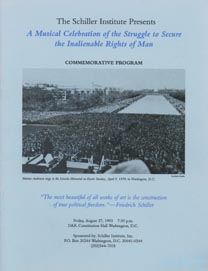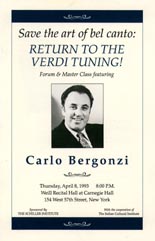Book Review:
Emma Azalia Hackley, 1867-1922
African-American Singer
and Social Activist
by Susan W. Bowen
Book Review:
A Biography of E. Azalia Hackley, 1867-1922
African-American Singer and Social Activist
by Lisa Pertillar Brevard
Lewiston, N.Y.: Edward Mellen Press, 2001, 390 pages,
hardbound, $129.95
Lisa Brevard's biography of Emma Azalia Hackley (1867-1922) tells the story of a remarkable, but little-known African-American woman, who, during a cultural ``little dark age'' in America, fought to bring Renaissance culture and education to former slaves and their children.
Born in Tennesee and raised in Detroit, Michigan, Emma Azalia Hackley described herself as a ``race musical missionary''-- that is, a role model, who took personal responsibility to educate African-Americans in the best of Classical culture, in order to uplift them, especially the poor, in both the North and post-Reconstruction South. She was part of the generation of African-American artists and intellectuals which included such luminaries as Paul Laurence Dunbar, Charles W. Chesnutt, Booker T. Washington, W.E.B. DuBois, Henry O. Tanner, and Ida B. Wells.
By 1901, Hackley was already a well-known concert soprano, Classically trained in the {bel canto} tradition. She began to devote herself to what became her life's work: spiritually uplifting an entire population through Classical music, whose {intention} is expression of the dignity of man in the image of God. It would take another 30 years before Marian Anderson, representing the same tradition, could break through and become recognized as a model of Classical culture for all Americans.
At the turn of the century, there was a lively Classical music presence among African-American communities. Hackley was active in the Washington Conservatory of Music, the National Association of Negro Musicians, and many similar organizations. She also worked to found ``people's choruses,'' which she organized others to continue, when she moved on to new communities.
In 1913, for example, when the People's Choral Society she had founded gave their seventh concert with a new conductor, performing Felix Mendelssohn's oratorio Elijah,the soloists included Roland Hayes, tenor, who was just beginning his international career, and Harry T. Burleigh, baritone, the composer of many beautiful settings of African-American spirituals and collaborator of Antonin Dvorak. Hackley's Chicago-based Vocal Normal Institute gave concerts to raise funds to send gifted African-American students to Europe for training.
"Teacher of Ten Thousands"
What earned Madame Hackley, as she insisted upon being called, the wonderful epithet ``Vocal Teacher of Ten Thousands,'' was her continuous organizing of huge community concerts and mass Folk Festivals, for which she travelled to big cities and small towns throughout the nation, including the deep South, wielding the weapon of Classical music to reach deep into the souls of whomevershe touched. Self-financed and self-promoted, a concert would be scheduled for her, as the main draw, to perform operatic arias, other Classical compositions, and African-American spirituals, to which would be added choral performances by local people.
When she arrived at the concert location, she would gather the local church or community chorus and whoever wanted to sing--often a few hundred voices of varied skill and capability--train them for approximately ten days, and then conduct them in concert. Sometimes, she would share the stage with promising local singers or musicians. Mme. Hackley would supplement the concert by giving free classes on ``voice culture,'' lecture demonstrations, and other workshops, which were emphatically not just about singing.
The purpose of these ``voice culture'' classes and demonstrations was to enable her students--children and grandchildren of former slaves--to discover within themselves a cognitive power, and to communicate it in song--Classical song--to others. A certain outlook is required for singing, Hackley would explain to her students: ``If one is a Somebody and has done nothing of which he is ashamed, one may look upwards towards the face of his Maker because he is in His image, and every line will say, `I am a Somebody....' ''
That she held such classes in the South, where this defiant teacher travelled even as Jim Crow laws were in effect, was not without major difficulties. Blacks who didn't ``know their place,'' or who ``stepped out of line,'' could pay with harassment and even their lives.
Poise of a "Somebody"
Working to instill a sense of purpose in everyone she could reach, Hackley authored short books and numerous periodical articles. She lectured at schools, colleges,churches, and communities. In her 1909 Guide to Voice Culture, Mme. Hackley developed a concept of the physical and cognitive processes involved in singing. The text conveys certain laws of physics which govern the production of sound, and other basics. But, what she begins with, and returns to throughout, is that a crucial mind-set is required if one is to create and communicate an idea.
Thus, while consciously working to create a beautiful {sound,} she was undertaking to create and develop beautiful souls. For example, in explaining the importance of voice placement, Mme. Hackley quotes Plato on the diaphragm. She explains how a high fixed chest will become a habit: ``This high fixed condition is the poise of a `Somebody,' and if one {is} a `Somebody,' his carriage should imply the fact.''
From December 1914 through March 1915, Mme. Hackley published a series of articles in the New York Age, titled ``Hints to Young Colored Artists.'' These included not only comportment in the professional world, but, as usual, in life itself. In the first section, ``How a Professional Achieves Success,'' she presents the key secret: ``Give to get.... Our world is what we ourselves make it. The world does not make our professional success.Whatever we reap we sow.''
From there, Mme. Hackley attacks many of the axioms of the ego-ridden ``professional world,'' while she simultaneously emphasizes that it is necessary for the artist to dignify the profession, and be above everything common. Even in discussing practical suggestions for successfully promoting a concert or attracting a following, she emphasizes the importance of character and garnering respect at all costs.
One of her two published books, The Colored Girl Beautiful (1916), was written at the request of Booker T. Washington, after Mme. Hackley had given a series of talks to the girls at Tuskegee Institute, which he had founded in Alabama. In it, she writes that colored children are born with the most beautiful eyes in the world, and that "the obligation of a gift is the preservation and cultivation of this gift. Little colored children should be taught to keep their eyes open and bright with intelligence and clear with good health, because the eyes are the windows to the soul. Their eyes should look straight into the eyes of others with their souls shining through.... Within each of them ... is an inward sculptor, Thought, who is a rapid, true workman.''
Time and again she returns to this idea, explaining, ``Thought will improve their good points and will eradicate objectionable points.'' Thus, a child should be given subjects to think about at an early age, and should be taught to see the ``beautiful in Nature and Art, that the reflection may be seen in her face and actions.''
Bridging the Gap
In Philadelphia, Mme. Hackley organized concerts in the churches (where, on one occasion, a 12-year-old Marian Anderson sang). She used the African-American Spiritual in her vocal teaching, consciously bridging the gap between the African-American elite and the working classes, as well as the Baptist, Methodist, and Episcopal churches.
Her students included those who went on to careers in music, as well as many recent migrants from the South, who worked the most menial jobs, and just wanted to learn, or to participate in her Folk Festivals.
The many press clippings from African-American newspapers and magazines of the day presented in Brevard's book, provide first-hand reports of the impact of this process. To appreciate the insights of such a remarkable teacher, however, it is best to read the stories woven by Mme. Hackley into her own writings, which, to author Brevard's credit, she published in full.
Living in the post-Reconstruction era, when minstrel shows became the norm of popular entertainment, Hackley's refusal to abandon her commitment to the coherence of culture and morality, and to the education and elevation of the spiritual qualities of even the lowliest of persons through great art, is a lesson well learned in the world in which we live today.

|
The Legacy of Madame Hackley
In the early 1990s, civil rights heroine Amelia Boynton Robinson and two other African-American legends, vocal coach Sylvia Olden Lee and operatic baritone Robert McFerrin, collaborated with Lyndon LaRouche on a project of making Washington, D.C., a desirable, safe, and beautiful place to live.
Rather than having children duck bullets while walking to school, LaRouche proposed a cultural intervention into the nation's capital.
Sylvia Olden Lee had already taken upon herself the mission of saving the African-American Spiritual, and insisted that renewing the practice of bel canto singing, would communicate the essence of this tradition.
Schiller Institute Vice Chairwoman Amelia Boynton Robinson revived the musical drama she had written in 1936, Through the Years, which incorporated many African-American Spirituals, and it was performed in American cities, with more than 1,000 children participating in Washington, D.C. alone.
The Schiller Institute sponsored free Classical concerts, featuring the best professional and also amateur Classical singers of opera, Lieder (German art songs), and spirituals. This work was advanced by an order of magnitude, when world-renowned baritone Dr. William Warfield joined the Schiller Institute Board in 1996, teaching master classes and holding concerts, workshops, and discussions, as well as instructing members of the LaRouche movement.
Most inspiring, Dr. Warfield, a student of the tradition represented by the almost-forgotten Mme. Hackley, coached members of the LaRouche Youth Movement, until his death in August 2002
. With his coaching, young men and women were steeped in singing {Lieder} and Spirituals, and in the lost art of poetry recitation, presenting the works of Keats, Shelley, Shakespeare, Schiller, as well as the late-19th-Century African-American poet Paul Laurence Dunbar.

|
 |
 |
|
| Singers Honor Marian Anderson in Washington, DC, at the Schiller Institute Free Concerts | ||
| Program for the 30th Anniversary of Dr. King's 1963 March on Washington | Carlo Bergonzi and the Schiller Institute Demonstrate theSuperiority of Verdi's Pitch C=256 |
Related Pages:
Click On Each Photo Above for More Links
What is the Schiller Institute?
American Classical Renasissance
The African-American Spiritual: Beauty, Not Force, Will Change America
1990s Schiller Institute Concerts
Fidelio Table of Contents from 1992-1996
Fidelio Table of Contents from 1997-2001
Fidelio Table of Contents from 2002-present


